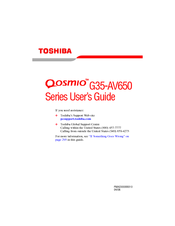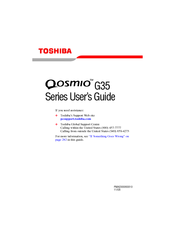Toshiba Qosmio G35-AV650 Series Manuals
Manuals and User Guides for Toshiba Qosmio G35-AV650 Series. We have 3 Toshiba Qosmio G35-AV650 Series manuals available for free PDF download: User Manual, Detailed Product Specification
Toshiba Qosmio G35-AV650 Series User Manual (394 pages)
G35-AV650 User's Guide
Table of Contents
-
-
Introduction36
-
This Guide37
-
Safety Icons38
-
-
-
Saving Your Work101
-
File Names102
-
-
-
-
Battery Notice115
-
Power Management116
-
-
Traveling Tips132
-
-
-
XP Media Center168
-
Edition 2005168
-
Recording TV195
-
-
Playing a Song207
-
Watching a DVD216
-
More Programs227
-
Online Spotlight228
-
-
-
Fn-Esse231
-
Hotkey Utility235
-
Toshiba Assist236
-
Connect237
-
Secure237
-
Protect & Fix238
-
Optimize238
-
-
Power Management240
-
Mouse Utility243
-
-
-
Using RAID266
-
-
-
-
A Plan of Action300
-
Memory Problems304
-
Display Problems308
-
PC Card Problems315
-
Printer Problems318
-
Modem Problems319
-
-
-
Volume Mute337
-
Power Usage Mode340
-
Standby Mode340
-
Hibernation Mode341
-
Display Modes342
-
-
-
Toshiba Computer346
-
-
-
Getting Started347
-
-
Profile Settings359
-
Quick Connect366
-
Glossary372
-
Index387
-
Advertisement
Toshiba Qosmio G35-AV650 Series User Manual (382 pages)
Toshiba Qosmio Laptop PC User's Guide
Table of Contents
-
Introduction36
-
This Guide37
-
Safety Icons38
-
-
-
File Names96
-
-
-
Battery Notice108
-
Power Management109
-
-
Traveling Tips125
-
-
-
Recording TV186
-
-
Playing a Song198
-
Watching a DVD207
-
More Programs218
-
Online Spotlight219
-
-
Fn-Esse222
-
Hotkey Utility226
-
TOSHIBA Assist227
-
Connect228
-
Secure228
-
Protect & Fix229
-
Optimize229
-
-
Power Management231
-
Mouse Utility233
-
-
-
Using RAID257
-
-
-
-
A Plan of Action289
-
Memory Problems293
-
Display Problems297
-
PC Card Problems303
-
Printer Problems307
-
Modem Problems308
-
-
-
Volume Mute326
-
Power Usage Mode329
-
Standby Mode330
-
Hibernation Mode331
-
Display Modes332
-
-
-
Computer336
-
-
-
Getting Started337
-
-
Profile Settings347
-
Quick Connect355
-
Glossary360
-
Index375
-
Toshiba Qosmio G35-AV650 Series Detailed Product Specification (11 pages)
Toshiba Qosmio G35-AV650: Specifications
Advertisement
Advertisement


